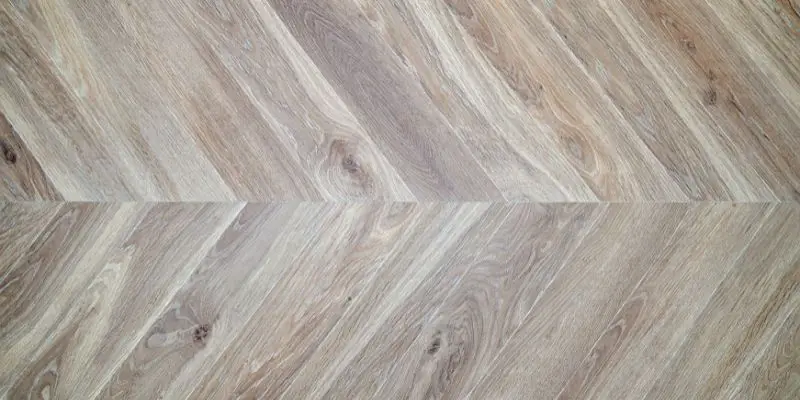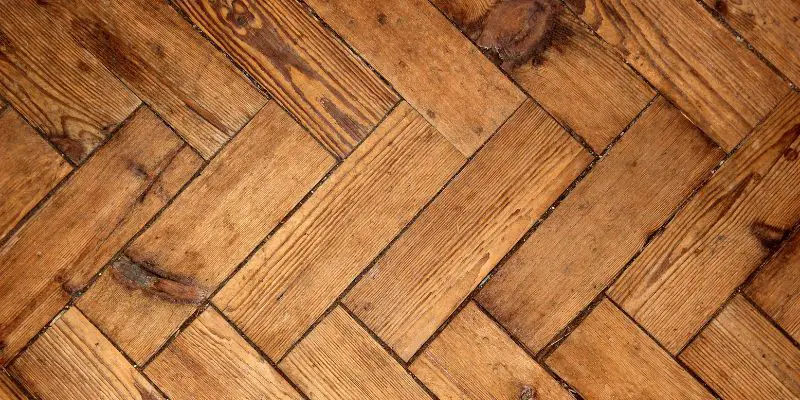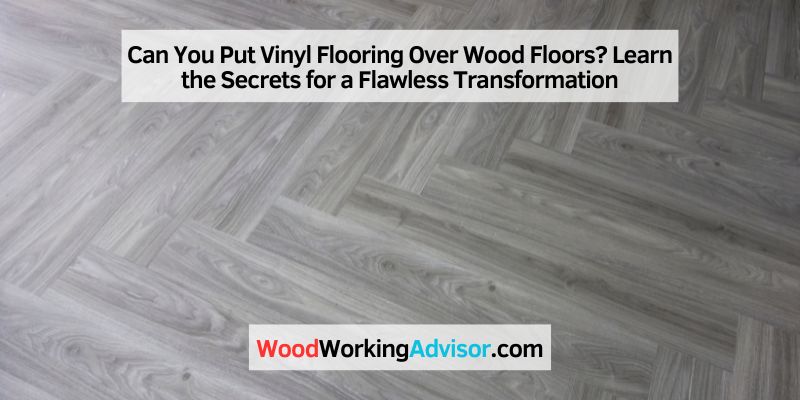Yes, vinyl flooring can be installed over wood floors with proper preparation and underlayment. Installing vinyl flooring over wood floors is a practical and cost-effective option for homeowners looking to update their existing floors.
With careful preparation and the use of an appropriate underlayment, vinyl flooring can be successfully installed over wood floors. This allows for a seamless and durable new floor surface, without the need for costly and time-consuming removal of the existing wood.
Whether you want to refresh the look of your home or create a moisture-resistant flooring option in areas such as kitchens or bathrooms, vinyl flooring over wood floors offers a versatile and practical solution. Before installation, ensure that the wood floors are clean, dry, and structurally sound, and choose a suitable vinyl flooring type and underlayment for optimal results.
Preparation
Yes, you can install vinyl flooring over wood floors, but preparation is crucial for a successful installation. You need to ensure the wood floors are clean, smooth, and level before laying the vinyl to prevent any issues such as bumps or imperfections.
Proper preparation will help the vinyl flooring adhere securely and provide a more durable and attractive finish.
Checking The Condition Of The Wood Floors
Before installing vinyl flooring over wood floors, it is crucial to assess the condition of the existing surface. This step ensures a long-lasting and durable installation. Carefully inspect the wood floors for any signs of damage, such as cracks, warping, or decay. These issues, if present, can compromise the structural integrity of the vinyl flooring.
Additionally, check for any protruding nails that may need to be hammered down or replaced. A smooth and level surface is essential for proper installation. Addressing any existing problems with the wood floors ensures a solid foundation for the vinyl flooring, preventing future issues.
Cleaning The Wood Floors
Once you have confirmed that the wood floors are in good condition, it’s time to thoroughly clean them. Remove any debris, dust, or dirt that may have accumulated over time, as these can affect the adherence of the vinyl flooring.
Start by sweeping the floors with a broom to remove loose particles. Use a vacuum cleaner to get rid of smaller debris that may be trapped in crevices or corners. For a deep clean, consider using a damp mop with a mild wood floor cleaner. Ensure that the wood floors are completely dry before proceeding to the next step.
Preparing The Wood Floors For Installation
In addition to checking and cleaning the wood floors, there are a few more steps to take to prepare them for vinyl flooring installation. First, remove any baseboards or trim that may be in the way, as these can interfere with the installation process. It is also essential to ensure that the subfloor is level and even. Any areas that are uneven can cause the vinyl flooring to buckle or warp over time.
If necessary, use a leveling compound or self-leveling underlayment to create a smooth surface. Allow ample time for the compound to dry or settle before proceeding with the vinyl flooring installation.
Lastly, to promote a better bond between the wood floors and the vinyl flooring, it is recommended to roughen the surface slightly using sandpaper. This process helps ensure maximum adhesion, enhancing the longevity and stability of the installation.

Underlayment
When it comes to installing vinyl flooring over wood floors, one important factor to consider is the underlayment. The underlayment acts as a cushioning layer between the vinyl and the wood floor, providing stability, moisture protection, and enhanced sound insulation. By selecting the right underlayment and installing it correctly, you can ensure a smooth and durable vinyl flooring installation.
Selecting The Right Underlayment
Choosing the appropriate underlayment is crucial to ensure the longevity and performance of your vinyl flooring. Here are some factors to consider:
- Moisture Protection: Look for underlayment with moisture barrier properties to prevent any water damage that may come from below the wood floor.
- Subfloor Imperfections: If your wood floor has any imperfections like cracks or uneven areas, select an underlayment that can provide extra cushioning and help level the surface.
- Sound Insulation: If reducing noise transmission is a concern, opt for underlayment with sound insulation properties to minimize sound transfer between floors.
- Thickness: The thickness of the underlayment plays a role in supporting the vinyl flooring. The manufacturer’s recommendations for thickness should be followed for optimum performance.
Installing The Underlayment
Proper installation of underlayment is essential for a successful vinyl flooring installation. Follow these steps to ensure a smooth process:
- Clean and Prepare the Wood Floor: Remove any debris, dust, or adhesive residue from the wood floor to create a clean and smooth surface for the underlayment.
- Roll Out the Underlayment: Begin by unrolling the underlayment across the entire floor, leaving enough excess material along the walls for trimming.
- Secure the Underlayment: Use adhesive or tape recommended by the underlayment manufacturer to secure the underlayment in place. Follow the manufacturer’s instructions for the appropriate application method.
- Trim Excess Underlayment: Once the underlayment is secured, trim any excess material along the walls using a utility knife or scissors.
- Ensure Proper Coverage: Make sure the underlayment covers the entire wood floor area, including corners and edges, without any gaps or overlaps.
By carefully selecting the right underlayment and installing it correctly, you can ensure a solid foundation for your vinyl flooring over wood floors. This not only enhances the durability and performance of your flooring but also provides a comfortable and enjoyable living space for years to come.
Vinyl Flooring Installation
Vinyl flooring can be easily installed over wood floors, providing a durable and stylish option. This seamless installation not only saves time but also creates a smooth and appealing surface for your home.
Choosing The Vinyl Planks Or Tiles
Before starting the installation, choose between vinyl planks and tiles. Consider the overall look and feel you want to achieve. Vinyl planks give the appearance of hardwood floors, while tiles offer a more traditional aesthetic.
Laying The Vinyl Flooring
Ensure the wood floors are clean and free from any debris or damage. Use a self-leveling compound if there are any imperfections. Lay the vinyl flooring in the direction of the longest wall to create a more spacious appearance. Carefully measure and cut the planks or tiles to fit the space.
Finishing Touches
Finishing touches are essential when it comes to any home improvement project, and installing vinyl flooring over wood floors is no exception. In this section, we will cover two crucial aspects of completing your vinyl flooring installation: Trim and Molding Installation, as well as Final Inspections and Touch-Ups. These final steps will ensure a seamless and polished look for your new vinyl floor. Let’s dive in!
Trim And Molding Installation
Trim and molding installation is the key to achieving a professional and refined appearance when installing vinyl flooring over wood floors. By using the appropriate trim and molding, you can create smooth transitions between the vinyl flooring and adjacent surfaces, such as walls and doorways. Here are a few essential tips to guide you through this stage:
- Measure and cut the trim or molding pieces according to the length required for each section. Be sure to use a miter saw or other suitable cutting tool for accurate and clean cuts.
- Apply adhesive to the backside of the trim or molding, following the manufacturer’s instructions. This will ensure a secure bond and prevent any movement over time.
- Align the trim or molding with the edges of the vinyl flooring, carefully pressing it into place.
- Use finishing nails or brad nails to further secure the trim or molding. Remember to countersink the nails slightly below the surface and fill the holes with wood filler for a seamless finish.
- If necessary, repeat the process for any additional trim or molding required to complete the desired look.
Final Inspections And Touch-ups
Final inspections and touch-ups play a crucial role in ensuring the success of your vinyl flooring installation. Taking the time to carefully inspect and make any necessary touch-ups will result in a flawless and long-lasting flooring solution. Here are a few final steps to consider:
- Closely examine the entire surface of your vinyl flooring for any visible defects, scratches, or imperfections.
- If you notice any blemishes, use appropriate touch-up products that match the color and texture of your vinyl flooring. Carefully follow the instructions provided by the manufacturer for best results.
- Once touch-ups are complete, use a soft cloth or mop to gently clean the entire floor, removing any dust, debris, or excess touch-up products.
- Double-check all edges, corners, and transitions to ensure they are smooth and firmly in place.
- Finally, take a step back and admire your newly installed vinyl flooring. You’ve successfully transformed your wood floors, giving them a fresh and modern look!
Maintenance And Care
Keeping your vinyl flooring in excellent condition requires regular cleaning and proper maintenance. By following some simple tips, you can prolong the lifespan and beauty of your vinyl flooring, even if it’s installed over wood floors.
Cleaning And Maintenance Tips
Regular cleaning is essential for maintaining the shine and cleanliness of your vinyl flooring. Here are some cleaning and maintenance tips to keep in mind:
- Sweep or vacuum the floor regularly to remove dust, dirt, and debris.
- Use a damp mop or cloth to clean spills and stains immediately. Avoid using excessive water to prevent damage to the wood floor beneath.
- For more stubborn stains, use a mild cleaning solution specifically formulated for vinyl flooring. Avoid using abrasive cleaners or brushes as they can cause scratches.
- Avoid using steam cleaners on vinyl flooring as they can potentially damage the adhesive that holds the flooring in place.
Protecting The Vinyl Flooring
To protect your vinyl flooring and ensure its longevity, here are some measures you can take:
- Place doormats at entryways to keep dirt and moisture from being tracked onto the vinyl floor.
- Use furniture pads or coasters under heavy furniture to prevent indentations or scratches.
- Avoid dragging heavy objects across the floor. Instead, lift and place them carefully.
- Consider using rugs or mats in high-traffic areas to minimize wear and tear.
- Close curtains or blinds during peak sunlight hours to prevent excessive fading or discoloration.
By following these cleaning, maintenance, and protection tips, you can ensure that your vinyl flooring remains in top-notch condition, even when installed over wood floors. Regular care will help keep your vinyl flooring looking its best for years to come.

Frequently Asked Questions On Can You Put Vinyl Flooring Over Wood Floors
Should I Remove Hardwood Floors Before Installing Vinyl Plank Flooring?
Yes, it is recommended to remove hardwood floors before installing vinyl plank flooring. This ensures a smooth and even surface for the new flooring and avoids any potential issues with uneven heights or moisture trapping between the two materials.
Do I Need Underlayment For Vinyl Plank Flooring Over Hardwood?
Yes, underlayment is recommended for vinyl plank flooring over hardwood to provide cushioning, sound absorption, and a moisture barrier.
What Is The Best Flooring To Put Over Hardwood Floors?
The best flooring to put over hardwood floors is engineered wood or laminate. These options are durable, easy to install, and won’t damage your existing hardwood. They also come in a variety of styles and finishes to match any decor.
Will Vinyl Floor Stick To Wood?
Yes, the vinyl floor can stick to wood with proper installation. As long as the wood subfloor is clean, smooth, and free of any imperfections or moisture issues, vinyl flooring can adhere well to it. Make sure to follow the manufacturer’s recommendations for installation to ensure a secure and long-lasting bond.
Conclusion
It is possible to install vinyl flooring over wood floors with proper preparation. This cost-effective solution can provide a fresh and durable surface, saving both time and money. It’s important to follow manufacturer guidelines and ensure the wood floor is in good condition before proceeding with the installation.
With careful planning, vinyl flooring can be a great option for updating and refreshing your space.



One thought on “Can You Put Vinyl Flooring Over Wood Floors? Learn the Secrets for a Flawless Transformation”